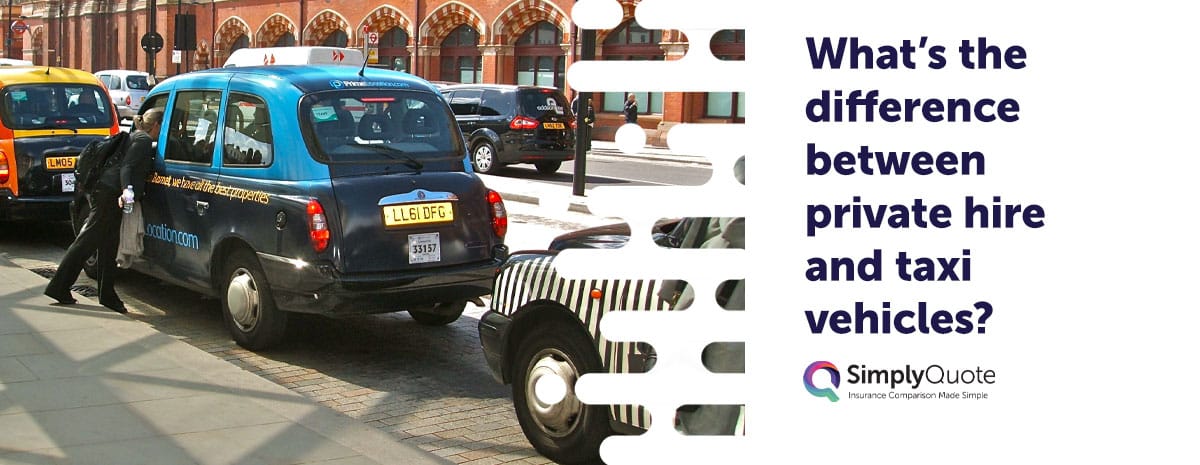What’s the difference between private hire and taxi vehicles?
The main difference between private hire and taxi vehicles is how they are hired. Private hire drivers transport passengers who have booked taxi services through ride-hailing apps, whereas taxi drivers “ply for hire” at taxi ranks or on the street corner.
While both types of vehicles offer hire and reward services, they differ in terms of appearance, fares, and insurance. We understand how confusing this might sound, so let’s explore the nuances of the two.

Private hire and taxi differences: Quick Overview
Private hire vehicles (PHVs) are taxi services booked via ride-hailing apps like Uber or Bolt. Licenced taxis, also called hackney carriage vehicles, pick up passengers who flag them down on the curb or at a taxi rank.
Here’s a quick comparison:
| Feature | Private Hire Vehicle (PHV) | Taxi (Hackney Carriage) |
|---|---|---|
| Booking | Pre-book via phone, app or scheduling platform | Hailed on the street/taxi rank |
| Availability | Bookings only | Immediate |
| Regulation | Depends on local authorities | Strictly regulated |
| Fares | Operators can set their own rates | Metered |
| Vehicle Type | Various (saloons, minibuses, limousines, etc.) | Typically standard saloon (must be wheelchair accessible) |
Let’s jump into the nitty gritty details of each, next.
Looking for cheap taxi insurance? Get your quote today!
Get QuotesPrivate hire vehicles: Explained
Private hire vehicles, also called minicabs, are popular transport options not only in the UK but across the globe. As we’ve established, private hire drivers pick up passengers who have made a prior booking, usually via a booking app or hotel concierge. Private hire vehicles must be pre-booked through a licensed operator, as it’s illegal to pick up passengers without a prior booking.
You may think that private hire vehicles only refer to Uber drivers, but this isn’t always the case. Other types of private hire services include:
- Airport shuttles
- Private tour guides
- Chauffeurs
- Executive cars
- Nursing home/school transportation
Appearance
Private hire vehicles can be identified by:
- Door signs on both front doors.
- A yellow licence disc/card on the front and rear windscreens, showing the licence expiry date, vehicle registration, and the number of passengers the car can carry.
- May have an optional Transport of London (TfL) “pre-booked only” sticker, if you’re a London taxi driver.
- A yellow licence plate at the back of the vehicle.
Note: Private hire drivers must wear their photo ID while on shift, showing their name and licence number.
Taxi fares
Private hire taxi fees are usually quoted upfront. This allows passengers to know the exact cost of their journey before getting into – and booking – a PHV. In some cases, passengers may negotiate better rates with a private taxi driver, especially for longer trips or group bookings.
The local council cannot set taxi fares for private hire vehicles.
Taxi insurance
Anyone operating as a private hire driver needs private hire or PCO taxi insurance with at least third-party cover. It’s a type of hire-and-reward insurance, specifically designed for drivers who work with pre-booked journeys in exchange for cash.
Comprehensive policies typically cover public and passenger liability and vehicle damages. It protects taxi drivers against third-party claims should they injure someone while behind the wheel.
The cost of minicab insurance varies greatly, depending on several factors:
- Driver age
- UK location
- Licence points
- No-claims bonus record
- Vehicle make and model
- Average mileage
Pro tip: Compare private hire insurance quotes with SimplyQuote‘s online comparison tool.
Taxis: Explained
Taxis, also known as hackney carriages, are a distinctive form of transport in the UK and have become synonymous with London black cabs. Pre-booked journeys do not apply to taxis as these cabbies pick up hailed passengers from the side of the street or taxi ranks.
Let’s take a closer look:
Appearance
Hackney carriages can be identified by:
- A “Taxi” or “For hire” roof sign that lights up when the taxi is available
- A yellow or green taxi licence disc on the rear and front windscreen. If the cab has a yellow licence, it means the driver can work in local suburban areas; a green licence means you have an “all London taxi driver”.
- Must be wheelchair-accessible vehicles.
- A taximeter (inside the vehicle).
- A blue and white plate at the back of the vehicle.
Note: Taxi drivers must wear either a yellow or green licence taxi operator badge that correlates with the above licence discs.
Taxi fares
The council sets taxi fares and taxi drivers cannot charge more than what is displayed on the taximeter at the end of a passenger’s journey.
Here are a few taxi fare examples as per the Transport for London guidelines:
- £7.60 – £11.80 per mile during the week
- £9.00 – £13.00 per mile on bank holidays
- £61.00 – £114.00 from Heathrow to central London
Taxi insurance
Taxis are purpose-built vehicles that transport members of the general public. Due to the nature of the job, these taxis must be insured under “public hire” insurance policies.
Insurance for taxis and private hire vehicles works exactly the same in terms of public liability and vehicle damages. The only difference is in the type of passenger you collect.
Pro tip: Compare public hire insurance quotes with SimplyQuote’s online comparison tool.
Final thoughts
As you can see, there are quite a few differences between taxis and private hire vehicles. While both offer transportation services, the key differences are how they are hired, how fares are set, and which type of taxi insurance applies to each.
You won’t see a “Taxi” sign on a private hire vehicle, nor will you find a taximeter inside the cab. Knowing these subtle key differences will help you make a more informed decision.
Be sure to compare hire and reward insurance quotes with SimplyQuote’s online comparison tool – the UK’s #1 comparison site for private hire and taxi drivers!
Frequently Asked Questions
Yes, Uber is a private hire vehicle, as passengers book taxi services in advance.
Generally, private hire services are cheaper than taxis because PHV operators can set their own rates whereas black cabs cannot. For instance, TfL monitors and regulates hackney carriage taxi fares in London.
No, private hire vehicles cannot collect passengers from a taxi rank.
Yes, anyone carrying passengers for hire and reward purposes needs taxi insurance in the UK. This applies to casual, part-time, or full-time taxi drivers in both the private and public hire sectors.
